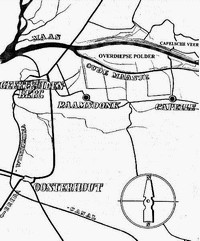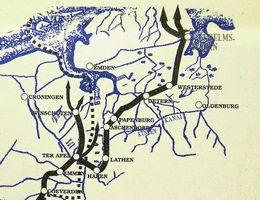
click on map to enlarge
The Allied Armies halted on Germany's Western frontier, making ready for a general offensive, probably to take place in the spring. In the North the front was established on the Maas.
The Division was in the neighbourhood of Breda and covered a sector on the river. It repelled several enemy attacks and prepared the defence in case of serious action.
On November 9 the Regiment was in Ulvenhout. It was considerably thinned after the three Month' s campaign, but supplies of men and equipment slowly poured in. All the winter they underwent intensive training, especially the young crews. Specialists were selected and the older ones gradually became leaders.
The Combat Squadrons were increased by an additional platoon. In each squadron one platoon was given "Challenger" tanks, one of the latest models, very similar to the Cromwell, but heavier and equipped with a powerful anti-tank gun.
A new unit was created, called the "Shock" platoon, which took the place of the Reconnaissance and the Rifles platoons, and consisted of 11 Stuart tanks without their turrets. These tanks have accommodation for a crew of four and are fully armoured. The work assigned to this platoon was the clearing of enemy pill-boxes, searching through localities and so on. This platoon was created with the knowledge gained from experience and on the Regiment's own initiative. The tanks were altered by the repair-unit of the Regiment.
Due to the Rundstedt offensive in the Ardennes and re-grouping of the 1st Canadian Army the Regiment was transferred on December 21 to another sector on the Maas, between Tilburg and 's-Hertogenbosch, and stationed in Udenhout and Kaatsheuvel. On January 8 1945, the Regiment was transferred to Teteringen where it remained until April 7.
The winter spent in Breda was seemingly quiet, but full of "front-events". Flying bombs were roaring by day and night to remind us of war. The Regiment, like all the other units was assigned a sector along the Maas, either to support the infantry or on their own, as was the case in early March in the Raamsdonk sector.
The Maas river is 400 metres wide with flat and wet banks, cut by ditches and dykes. The sectors to control were large and difficult to guard and an incalculable number of mines and other Booby-traps, the majority concealed, made every move a dangerous one. Even on familiar roads one could be blown up by mines, laid by German night-patrols who were frequent visitors. A strip of land along the Maas was kept under close watch from both sides and as the batteries were always on the alert and ready to fight, movement was only possible by night when red-indian like engagements took place. During the day the Cromwells advanced as far as the shore, setting fire to enemy houses and barges, and smashing pill-boxes with anti-tank ammunition. Both sides kept each other on the alert until April 7 when the Regiment left for the offensive on Germany.
The defence line on the Rhine was broken through and the final Allied offensive against Germany had begun. The Division were to cross the Rhine near Goch and Cleve and enter into action towards the port of Emden.
On the evening of April 7 the Regiment left Teteringen and moved to Coevorden to join the group of Lt. Col. Zgorzelski, CO of the Dragoon Regiment. The Regiment reached its destination on April 9 at 2 pm., after having covered 400 km in 40 hours and entered into action on the same day.
On the following day our Regiment supported by a squadron of dragons set out to rescue some French para-troops who, having completed their mission, were in a very precarious situation
behind the enemy lines. The Regiment rescued the remainder of this detachment from enemy territory and brought back the French Batallion' s CO with some para-troops. The CO related that he had been asking for help by radio to London for a long time and was told that he should hold on until noon, at which time the Poles would come to rescue. It was at noon that he heard our guns.
The Division, moving slowly by other roads, had not yet reached us and our group carried on its independent action towards the North-East. On the following day the Regiment supported the dragoons in their action against Emmen and reconnoitred as far as Ter Apel, Exlo and Odoorn. The 2nd squadron captured Veendam, a huge depot of German war material and equipment, thereby making a 40 km advance towards the North. The main difficulties of the Regiment, acting simultaneously in different directions, were the natural obstacles. The country was covered by a net of canals, roads, dykes and bridges, all thoroughly wrecked by the enemy.
GERMANY

click on map to enlarge
Eventually, on April 17 the Regiment, acting as the Division's reserve, halted in the Landegge area, North of Haren.
Our Division commenced an action against Papenburg and stopped before the strongly defended Küstenkanal. On April 19 the 10th Armoured Cavalry Brigade with the support of infantry battalions, air-force and strong artillery and flame-throwers forced the canal. The operation took place strictly according to previous orders and exactly to the time-table given for each arm and unit. This powerful blow was efflciently carried out and no enemy efforts could delay the action of our plan and Papenburg was taken.
On April 21 our Regiment was ordered to join an independent unit under Lt. Col. Nowaczynski and it moved to the re-grouping centre, east of Aschendorf. From there the independent unit was to act on the right flank of the Division north-east towards Apen. Until the end of the campaign the regions, we fought in, were similar to those of Moerdijk and Ter Apel. The thin surface of the roads on large stretches of peat and bottomless swamp often gave way under our tracks and it was impossible to rescue some of our tanks. The Germans used new methods of blowing up roads and bridges by burying air-bombs in the ground. Our Regiment fought against innumerable obstacles, often finding it necessary to lay miles of road with wood logs, and the engineers built hundreds of bridges. The enemy defended every passage despite heavy losses but our Division pushed steadily forward.
On April, 21st after heavy fighting the Regiment together with companies of the 8th Infantry Battalion reached Börgmor and stopped before a defended canal. During the following two days our Regiment was detached from the independent unit and with only a company of the 8th Battalion and after a day and night' s fighting reached Langholt, 20 km away, thereby unexpectedly thrusting a wedge into the enemy lines.
At that time the Regiment was cut off from the Division and its own rear and had no communication with them. All the roads and bridges had been blown by the enemy and our own road was hopelessly wrecked by tracks and locked by bogged tanks. For several days the Regiment was without supplies and had no means of evacuating the wounded men.
During the next five days, fighting in a labyrinth of roads and canals, the Regiment, together with the independent unit, reached Bollingen and Scharrel, pushing back the enemy eastwards and northwards beyond line of swamps.
At that time the Division reached the river Leda in the north and stopped before the strong defence of the enemy. Progress through this country was very difficult. Before a new action and after a re-grouping, our Regiment stopped April 28 in the evening, in Rhaudermeer to remain there as reserve to the Division. On the following day the Mounted Rifles celebrated their Regimental Day with a simple field-mass. Orders were then received by our CO for the following operations.
The Division standing before a strongly defended line of water obstacles was to carry on action towards Varel and Wilhelmshaven. On the left flank the 3rd Canadian Infantry Division forced the river passage and was assigned the task of seizing Leer, taking advantage of the river crossing established by the Canadians. Part of our Division was also ordered to cross and by an attack eastwards we appeared on the rear of the enemy, who were defending themselves against the bulk of our Division.
Our Regiment supported by a company of the 8th Infantry Battalion crossed the river and passed through the town of Leer, which had already been captured. While the 1st and 2nd Armoured Regiments fought on the main roads, our Regiment penetrated the enemy' s defence by side roads.
After a 25 km drive eastwards on the same day they also penetrated the small town of Remels, and carried on to an important bridge leading farther east-wards. Knowing the value of surprise and blitz-action the Mounted Rifles spared no effort and pushed steadily over swamped roads and in pouring rain in every possible direction, although their forces were thin. Paying no heed to their own losses they spread out on the roads, and single platoons or even tanks took mined bridges and scattered frightened dynamiters. Only 5 tanks were left to attack Remels and the bridge on the Georfehner canal, but they completed these actions successfully.
All through the night they pulled their tanks out of the mud and before dawn they had sufficient to lengthen the push and take Grossander. Further on, however, our 1st squadrom met with stiff resistance and was compelled to stand on the only available road, under fire of several German tank guns which caused heavy losses. About noon the 10th Brigade arrived and continued this action.
The defence of the enemy had been penetrated by an attack on the rear and our Division was already able to build bridges in the direction it had been ordered. On May 4 the Regiment again preceded the Division and halted before a barrier of destruction, near Astederfeld and could only continue the fight by making a stand against the enemy. These were the last fights against the enemy's resistance on their own territory.
The Germans capitulated on May 5 at 8 am., both sides ceased fire and the campaign was ended.
OCCUPATION
After the end of hostilities on the 8 of May 1945 the Regiment passes over to the town Schortens, where it remains until May 20, 1945. During this period the Regiment controls the execution of the conditions of surrender of German troops located in the Regiment's area.
On 20 May 1945 the Division passes to the south of Küstenkanal. The Regiment is occupying quarters in the area of the crossroads of Haren.
One of the main tasks of the Regiment was the service of occupation on the territory between the river EMS and the Dutch border at the heights of Haren and Meppen.
The Regiment was taking care of Polish DP Camps located in Versen, Wezuwe, Walchum, Dalum and Maczków.
Besides the occupation service, classes of English and training courses for drivers and motor mechanics were held by the Regiment. Training courses for civil jobs were established by the Division for all EM.
Due to the enlargement of the area occupied by the Division, on August 18, 1945 the Regiment was transferred to Aurich, where it remained stationed until March 24, 1947, i. e. until its departure to England.
During the stay at Aurich, the living and work conditions have eased and training courses for various trades have been established.
With the end of War a demobilization for volunteers started. Up to the date of embarkation to England there were redeployed:
TO POLAND 9 officers, 224 Oth. Rnk.
TO FRANCE, BELGIUM, HOLLAND and other countries: 136 EM.
Prior to embarkation to England 31 offc. 277 Oth. Rnk. declared their desire to enter the Polish Resettlement Corps.
|